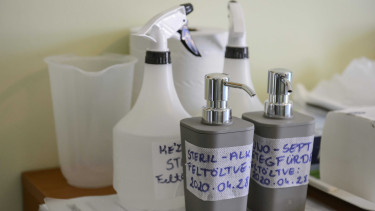Don't let Hungary's official vaccination rate fool you!

Let's kick off with a rather cryptic graph. To decipher it's meaning in full, please scroll down (while reading, of course).

Important note
Some of the unvaccinated people have certainly gained some level of immunity via infection, but there is no way to tell how many of them and when therefore we cannot calculate when their immunity against COVID-19 started to wane (it does not last forever, you know). All this would be crucial to know for more accurate calculations, but at this point we do not believe such fine-tuning of estimates would make either much sense or difference. The big picture would not change materially in any case.
Yet, if you think that the numbers you'll find below are farfetched or too shocking, feel free to divide them as you wish, depending on what percentage of 'natural immunity' you think the Hungarian society currently has.
Local authorities share very little and low-quality data about the pandemic. For instance, they refuse to disclose the vaccination status of Covid patients that are hospitalised, end up on ventilator and eventually in die. Government officials downright deny having such figures, while it is a preposterous claim, considering that based on the social security number ('TAJ-szám') all such information are in the system.
How many of us are actually protected against coronavirus infection?
There are officially about four million Hungarians that are not protected against coronavirus via vaccination. But let’s look at this from the other side. There are about 5.8 million fully vaccinated people in Hungary. This means two doses (or one in the case of the single-dose Johnson & Johnson vaccine Janssen) were administered to 5.8 million people in the country.
What if we told you that in a worst-case scenario, disregarding immunity by infection, fewer than 1.9 million people are protected with the highest possible effectiveness provided by the various COVID-19 vaccines against infection in the population older than 12 years of age?
What if we told you that even in a best-case scenario there are fewer than 3.5 million people protected against coronavirus infection?
Coronavirus has been spreading rampantly in Hungary. There were more than 27,000 new cases, and nearly 400 Covid deaths in the country over the past three days. The number of coronavirus patients in hospital rose 62% in two weeks and there are now 50% more of them on ventilator than a fortnight ago.
As recently as in mid-September, a leading health care ‘professional’ with influence on government policy, stated with great confidence off the record that 50% of the population has already contracted coronavirus and with overall immunity being greater than 70% (including protection via vaccination) it was impossible that authorities would diagnose more than 1,000 new COVID-19 cases per day, and that there would be hardly any Covid deaths; the ‘fourth wave’ would be only symbolic.
The government has reluctantly implemented a handful of restrictions, but it continues to rely on vaccinations. The problem is that the vaccination rate is stuck around 60% and while third doses remain much more in demand than 1st and 2nd jabs combined, the waning effectiveness of vaccines means that an increasing percentage of those fully vaccinated in the basic protocol are actually no longer protected, or not to the extent they were a few months earlier.
Waning effectiveness – What does it mean?
Several studies of vaccine effectiveness have been conducted in the UK which indicate that 2 doses of vaccine are between 65 and 95% effective at preventing symptomatic disease with COVID-19 with the Delta variant, with higher levels of protection against severe disease including hospitalisation and death. There is some evidence of waning of protection against infection and symptomatic disease over time, though protection against severe disease remains high in most groups at least 5 months after the second dose.
“Based on antibody testing of blood donors, 98.0% of the adult population now have antibodies to COVID-19 from either infection or vaccination compared to 18.7% that have antibodies from infection alone,” the UK Health Security Agency said in its COVID-19 vaccine surveillance report for up to Week 44 (7 Nov).
Hungarian authorities have long given up tracking the spread of coronavirus, and we should not expect any similar data or estimates from them. The UK figure, however, may be applied to Hungary too, given that the level of restrictions has been lower in Hungary than in the UK since mid-May.
- Effectiveness against symptomatic disease
After two doses, observed vaccine effectiveness against symptomatic disease with the Delta variant reaches approximately 65 to 70% with AstraZeneca Vaxzevria and 80 to 95% with Pfizer-BioNTech Comirnaty and Moderna Spikevax, the HSA said.

- Effectiveness against hospitalisation
Effectiveness against hospitalisation of over 90% is also observed with the Delta variant with all 3 vaccines. In most groups there is relatively limited waning of protection against hospitalisation over a period of at least 5 months after the second dose. Greater waning appears to occur among those in clinical risk groups

- Protection against mortality
High levels of protection (over 90%) are also seen against mortality with all 3 vaccines and against both the Alpha and Delta variants. Relatively limited waning of protection against mortality is seen over a period of at least 5 months.

- Effectiveness against infection
With the delta variant, vaccine effectiveness against infection has been estimated at around 65% with Vaxzevria and 80% with Comirnaty.
- Effectiveness against transmission
A household transmission study in England found that household contacts of cases vaccinated with a single dose had approximately 35 to 50% reduced risk of becoming a confirmed case of COVID-19. Data from Scotland has also shown that household contacts of vaccinated healthcare workers are at reduced risk of becoming a case, which is in line with the studies on infection. d. An analysis from the ONS Community Infection Survey found that contacts of vaccinated index cases had around 65-80% reduced odds of testing positive with the Alpha variant and 35 to 65% reduced odds of testing positive with the Delta variant compare to contacts of unvaccinated index cases.

So, how’s the situation in Hungary? In short: not good.
There are several factors we need to consider when assessing the situation on the vaccination front.
- About 40% of the total population, i.e. some four million people are not vaccinated against SARS-CoV-2.
- The effectiveness of all vaccines wanes over time (see above).
- The Delta variant is more contagious than the previous strains.
- There are hardly any restriction measures in place in Hungary.
- People are reluctant to get their jabs, even though those that had already had two doses do seek to get their third. However, even third doses are not administered to as many people as they should be.
- In a best-case scenario, more than 5.1 million Hungarians are either unvaccinated, or their second shot was administered at least six months ago.
- In a worst-case scenario (when we calculate with vaccine effectiveness down after four months), there are as many as over 6.7 million people in this partly protected group.
First, let’s see Hungarians’ willingness to get inoculated against coronavirus.


Read our previous report on vaccine effectiveness and the importance of third doses here.
The waning effectiveness of various COVID-19 vaccines and the impact of third doses on antibody levels was the subject of a recent trial by Hungarian company Videoton, which recommended getting a third jab, particularly for elderly people vaccinated with China’s Sinopharm. Recipients of Sinopharm, particularly those over 60 years of age a lot of subjects had extremely low antibody levels. In fact, some had no protection whatsoever, ie. either antibodies or T-cells. Following a third dose of Pfizer-BioNTech's vaccine their antibody level skyrocketed, though.
Here are a couple of charts on the vaccination status of the 60+ age group in Hungary.


The results of a substantially larger new trial (not even in the same league as that of Videoton) were published recently in The Lancet. It follows 3.4 million people who were fully vaccinated with Pfizer’s jab.
3rd doses in three scenarios
We could (and perhaps should) calculate how many people in which age group are due for a third dose after receiving two doses of what vaccine, but… it really makes no sense without having much more information on the recipients of 3rd doses. Currently we have nothing to go buy except a nice round figure the official government portal reports on weekdays.
Yet, we can make a rough estimate under various scenarios on how many people in total could request for a 3rd dose.
These scenarios assume that vaccine effectiveness starts to wane (i) 4 months, (ii) 5 months, and (iii) 6 months after full vaccination is reached.
We also provide a breakdown by vaccines but not by age groups (this time).
There are two more ‘groups’ we need to add to those that had both COVID-19 vaccine doses (or just one if it was Johnson & Johnson’s single dose Janssen vaccine), namely the unvaccinated adult population and those in the 12-17 age group that are eligible for vaccines but have not requested the shots. (It’s not a widely known fact that Moderna shots have also been given to those between 12 and 17 since 2 August. Authorities said earlier that adolescents would receive only Pfizer-BioNtech jabs. Only 501 first and 391 second doses of Moderna’s vaccine have been administered so far, though.)
- 4 months after full vaccination
As you can see, the vaccination situation becomes rather worrying under the first scenario in which we assume that vaccine effectiveness starts to wane four months after the second dose. In that case, we have more than 6.74 million people either without any vaccination (2.88 mn) or with diminished immunity to infection (cc. 3.86 mn).
In this scenario we have roughly 1.59 million people with ‘full protection’ against SARS-CoV-2 in the adult population, and 1.87 million when we add those in the 12-17 age group.
- 5 months after full vaccination
Under the second scenario (vaccine effectiveness starts to wane after five months), there would currently be some 6.3 million people in the country either unvaccinated or with diminished protection from infection.
In this scenario we have 2 million people with ‘full protection’ against SARS-CoV-2 in the adult population, and 2.32 million when we add those in the 12-17 age group.
- 6 months after full vaccination
In the best-case scenario (assuming that lower immunity to infection starts after six months), there would still be 5.15 million people with no or diminished immunity to infection, and a staggering 2.27 million of them would still need a third dose to fix the problem.
In this scenario we have roughly 3.17 million people with ‘full protection’ against SARS-CoV-2 in the adult population, and 3.46 million when we add those in the 12-17 age group.


The most vulnerable group
Finally, just a theoretical calculation regarding the most vulnerable group, those over 60 years of age.
The assumptions regarding waning vaccine effectiveness remains the same, with scenarios drawn up for four, five, and six months post full vaccination. Given that there are no official data to go by, we assumed that (i) people in the 60+ age group were the only ones that received 3rd doses (this is obviously nonsense), (ii) half of the 3rd doses were administered in this age group, and (iii) one third of the 3rd jabs were taken up by people older than 60.
In the best-case scenario, some 100,000 people of over 60 years of age would still need a 3rd dose of a COVID-19 vaccine. This is highly unlikely, though. Even if vaccine effectiveness against infection is diminished greatly only after six months, there is no way only 60+ people got 3rd doses in Hungary.
In the worst-case scenario (effectiveness down after four months, 33% of 3rd doses administered in 60+ age group) there are nearly 1.5 million people in this age group alone that would need a 3rd jab to get their original immunity level back.


We shall see how vaccination rates (1st, 2nd, 3rd dose coverage) will change this week, as no prior registration is required for any of these shots, and people are reportedly queuing up for the jabs at vaccination locations.
Cover photo: Getty Images




